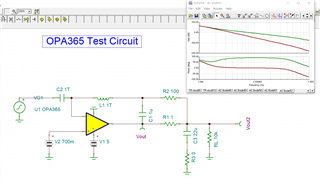Other Parts Discussed in Thread: TINA-TI,
Hello
I have designed simple 0.7V reference voltage follower buffer circuits with TINA-TI
I choose OPA365 because it have IN/OUT Rail to Rail and high Current supply with High Bandwidth, good offset voltage.
The R1 1ohm Resister is placed for driving high capacitive load.
However I'm confusing the stability simulation of this kind of circuit. Would you help me?
1. Is it correct to check the "Vout"(Green),which is a Direct Output of OPAMP. instead of actual output "Vout2"(Red) to analyze the stability?
I think it right to refer "Vout" pin for make Loop Gain point for negative Input.
"Vout"have about 90 degree phase margin. So It is very stable

However I will use the "Vout2" output for actual application. Is it ok?
2. The C1 is necessary?
I think it is for in loop compensation, but there is no changes even i get rid of the C1 at AC simulation.
I don't know why. Is it ok to get rid of this capacitor?


